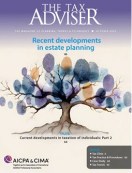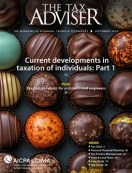- newsletter
- TAX INSIDER

SECURE Act changes rules to encourage retirement savings
Please note: This item is from our archives and was published in 2020. It is provided for historical reference. The content may be out of date and links may no longer function.
Related
Inflation adjustments to retirement account limits issued for 2026
Premium or paycheck? Tax treatment of secondary sales above FMV
Planning with charitable remainder trusts
The Setting Every Community Up for Retirement Enhancement (SECURE) Act of 2019 (Division O of P.L. 116-94) contains a wide assortment of changes to existing law, mostly designed to encourage retirement savings and to simplify administrative requirements to make it easier for employers to offer retirement plans.
The December 2019 legislation contains a few inconsistent notes, however. Most importantly, Congress included in the SECURE Act a taxpayer-unfriendly change that has generated significant discussion because of its impact on estate planning: Most beneficiaries of IRAs and qualified plans must withdraw all money from inherited accounts within 10 years.
Under prior law, beneficiaries were generally allowed to withdraw inherited amounts from a tax-favored account or plan over the beneficiary’s lifetime. Certain beneficiaries are exempt from the new 10-year limit: surviving spouses, minor children, chronically ill individuals, and individuals within 10 years of the deceased person’s age (Sec. 401(a)(9)).
Contribution and distribution age limits
Most of the SECURE Act’s other provisions for people saving for retirement are taxpayer-friendly. To begin with, two age rules have been adjusted to reflect longer life expectancies.
First, the act repeals the maximum age for contributing to a traditional IRA. Under prior law (former Sec. 219(d)(1)), individuals who worked past age 70½ were barred from continuing to contribute to traditional IRAs, but now traditional IRAs will be treated the same as Roth IRAs and employer-sponsored plans, which have no age limit. The act also reduces the amount of charitable IRA distributions allowed to taxpayers over 70½ (by the aggregate IRA contribution deductions allowed to them after they turn 70½), but does not raise the age requirement to make those charitable distributions (it is still 70½) (Sec. 408(d)(8)(A)).
Second, the act increases the age after which required minimum distributions from certain retirement accounts must begin to 72 (from 70½) (Sec. 401(a)(9)). The committee report explains that this is because Americans are living longer and more are working past traditional retirement ages (H.R. Rep’t No. 116-65, 116th Cong., 1st Sess., p. 74 (May 16, 2019)).
Expanded eligibility
The SECURE Act also expands eligibility rules to assist particular taxpayers in saving for retirement. The act makes it easier for long-term, part-time employees to participate in retirement plans. It does this by requiring Sec. 401(k) plans to permit an employee to make elective deferrals for retirement plans if the employee has worked at least 500 hours per year with the employer for at least three consecutive years and certain other conditions are satisfied (Sec. 401(k)(2)(D)). Under prior law, employers generally could exclude employees who worked less than 1,000 hours per year from participating in a plan.
The act allows certain home health care workers to make contributions to an IRA or defined contribution plan based on Sec. 131 difficulty of care payments, which are excluded from income (Sec. 408(o)(5)). In determining the amount of nondeductible contributions that can be made to an IRA, if the taxpayer has difficulty of care payments excluded from income, the nondeductible IRA contribution amount in effect for the tax year can be increased by the lesser of (1) the excluded difficulty of care payments, or (2) the excess of the payments over the amount of taxpayer’s compensation includible in gross income. In determining the contribution limit to an IRA or defined contribution plan, difficulty of care payments are treated as compensation or earned income (Sec. 415(c)(8)).
Graduate and postdoctoral students often receive stipends, fellowships, and similar payments that are not treated as compensation and cannot be used as the basis for IRA contributions. To allow these students to begin saving for retirement in IRAs, the act removes this obstacle by taking those amounts that are includible in income into account for IRA contribution purposes (Sec. 219(f)(1)).
Other changes affecting individuals
There are also other notable changes pertaining to individuals.
- Withdrawals for birth or adoption are exempt from the 10% additional tax on early distributions. The act allows distributions of up to $5,000 from qualified retirement plans and IRAs for birth and adoptions to not be subject to the 10% tax, with certain limitations (Secs. 72(t)(2)(H)).
- Portability of annuity contracts, etc. The act addresses portability issues for lifetime income products. For instance, if an employee has to liquidate such an investment held in an employer-sponsored retirement plan — perhaps because of a change in investment options or a limit on investments held in the plan — the employee may be subject to a charge or fee. The employee may be unable to avoid the charge or fee because of restrictions on in-service distributions. The act amends the law to allow distributions or rollovers in those cases (Secs. 401(a)(38), 401(k)(2)(B), 403(b)(7) and (11), and 457(d)(1)(A)).
—Dave Strausfeld, J.D., is a Tax Adviser senior editor. To comment on this article or suggest an idea for another article, contact him at David.Strausfeld@aicpa-cima.com.














